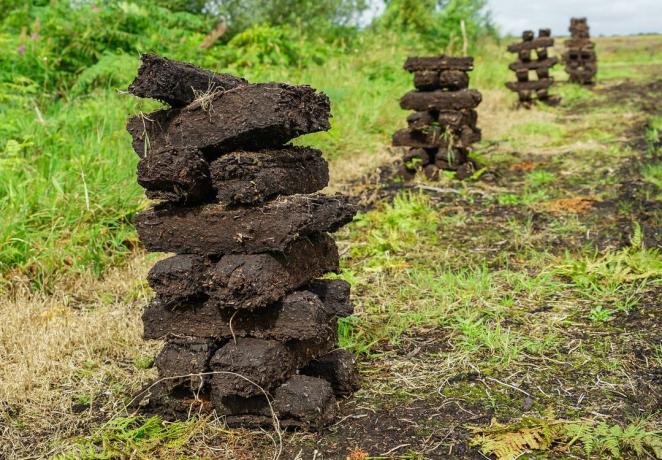Again and again one reads about peat-reduced soils and Co. But what exactly is peat and how is it created? We reveal whether peat is needed in the garden and why it should be used sparingly.

Peat is still the starting material for many potting soils. We explain what peat actually is, how it is formed and at the same time we would like to take a look into the near future. Because peat will soon only be used in small amounts in horticulture in order to protect the climate and valuable ecosystems.
"Contents"
- What is peat?
- How is peat formed?
- Peat in the garden: uses & alternatives
What is peat?
Peat is a form of humus, which arises in moors due to the lack of oxygen under water and the acidic pH value from dead moor plants. peat existsfrom incompletely decomposed and preserved plant remains, mainly from peat moss (sphagnum).
Because there are different types of bogs, peat can also vary in its properties. Peat from fens is strongly acidic to basic (pH 3.2 to 7.5), heavily decomposed and rich in nutrients. Raised bog peat, on the other hand, is highly acidic (pH 2.5 to 3.5), less decomposed and low in nutrients.
Only peat from raised bogs is used for horticulture. Old black peat is hidden several meters deep in the ground. It is fine and parts of the plant are hardly recognizable. Younger white peat can be found in the upper layers of the raised bog. With him you can still see the structure of the hardly rotted plants very well.
Because of its beneficial properties, raised bog peat is perfect for potting soil. Unfortunately, however, its extraction and use damages the environment both regionally and globally - for this reason it is Peat a climate and species killer in the garden.

Tip: Some readers may remember: Before it was used in potting soil, peat was burned for heating or used as bedding in animal stalls.
How is peat formed?
Peat is created by the accumulation of non-decomposed or hardly decomposed organic material in the absence of oxygen in water-saturated bogs.
Peat formation in moors began around 12,000 years ago. Because moors store a lot of rainwater or are fed from groundwater, they are water-saturated. Under these conditions, most decomposing organisms cannot live and do their work, or only poorly. For this reason, an ever thicker layer of plant material accumulates in bogs over time. This is reinforced by the establishment of a very high degree of acidity in some bog types. Because this deposited plant matter is largely made up of carbon compounds, peatlands are rightly identified as huge and important CO2storage devices that remove carbon dioxide from the atmosphere. However, when peat is used, it is released again - and thus fuels the greenhouse effect.

Peat in the garden: uses & alternatives
Peat has been used in horticulture for several decades. Because it has physical and chemical properties that are very beneficial to plant growth, it has long been an integral part of potting soil.
Because of its favorable pore size distribution, it can store a lot of water, without the roots of plants suffering from a lack of oxygen. Besides, his pH very low and can be easily adapted to the needs of each plant with the help of lime. When dry, it's fairly light, making it easy to transport. And last but not least, it is very low in nutrients. The nutrient content can also be individually adjusted for the plants to be cultivated. In addition, it is often used in bog beds because of its high acidity: Among other benefits Rhododendrons (rhododendron), hydrangeas (Hydrangea), skimmia (Skimmia japonica), lavender heather (Pieris japonica) as blueberries or blueberries (Vaccinium) very much from planting with peat.
But peat is becoming scarce: According to current forecasts, global peat reserves could only cover our needs for a few more decades. In addition, the removal of peat - no matter how gently it is carried out - releases large amounts of carbon dioxide into the atmosphere. Complete abandonment or at least a sharp reduction in use is therefore a worthwhile goal in view of climate change. Not only we rely on our peat-free and peat-reduced Plantura soils in organic quality on a turning point in the field of potting soil. Professional horticulture and of course environmental organizations as well as German and European nature conservation have also recognized: Peat-free and low-peat potting soils are the future and peat soils should be a thing of the past as soon as possible belong.
Peat-free or peat-reduced soils can be mixed from very different components: wood fiber, compost, sand, clay minerals, various coco materials, perlite and xylitol mixed in the right proportion can also satisfy the needs of our plants, just like peat. coconut pulp (also cocopeat, so „coconut peat“ called) has a very similar water and air capacity as peat. Clay minerals and compost ensure good nutrient storage capacity and perlite ensure good structural stability.
Tip: Incidentally, you can also mix peat-free potting soil yourself: If you have compost, we will explain how to do it here Mixing compost soil functions.

